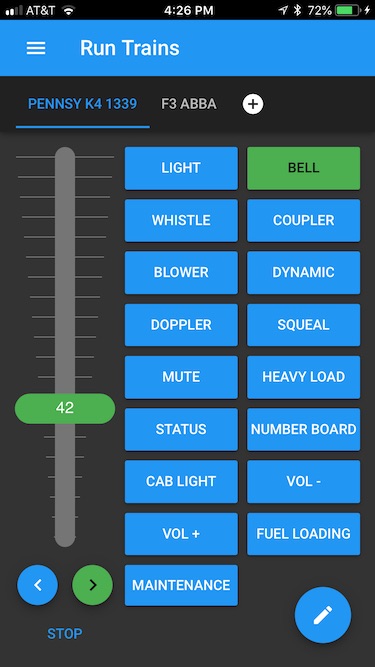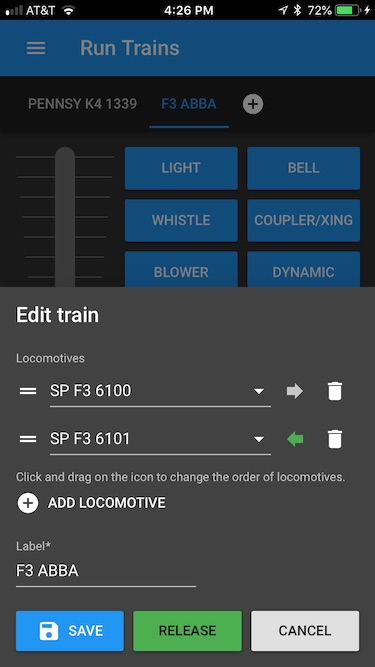RunTrains: A Web Based DCC Train Control System
RunTrains is a technology stack for running model trains, using a web server application and a single-page web app / PWA that can be used on a mobile phone or tablet.
This is an alternative to the JMRI WiThrottle and Engine Driver apps.
This system was was built to work with JMRI, which would be interfaced with a DCC command station. However this project is not in any way affliated with the JMRI project or JMRI community. You can learn more about JMRI and download it from http://jmri.sourceforge.net/.
Technology Overview
There are three building blocks in this solution:
-
RunTrains Web App: A React based client app, which can run directly on your local network, likely the same computer running JMRI and the RunTrains Server, or it can run from a static web host and connect in to your system over the Internet.
-
RunTrains Server: A Node.js based server, typically running on the same computer or LAN as JMRI, which connects with JMRI through the JMRI JSON API. If remote access to running trains is desired,you will need to forward the appropriate port in your router, and if you to want to run the web app as a PWA then you will need to use HTTPS. You can get a free SSL certificate from Let's Encrypt, and use Nginx to handle SSL termination and stream proxying.
-
JMRI: The Java Model Railroad Interface software is still necessary to connect to your DCC command station. JMRI throttles and apps can still be used as well.
Other technology details:
The server app is based on Express.js, using Babel to support ES6. The core functionality of the server is state management, using Redux. Redux is most often used on the client side, especially with React, but works great here as well. The server uses Apollo Server to provide a GraphQL API, including GraphQL Subscriptions for real-time updates. The server also a maintains a WebSocket connections to JMRI's JSON API, and uses polling to re-establish the connection if it is lost.
The client app was built using Create React App. It also uses Apollo Client for GraphQL communications with the server, Storybook for component testing, and Prettier for automatic code formatting.
History
I'm a software architect, focused on modern web technologies. And I'm a model railroader, with a G-scale backyard garden railway. In the past I used JMRI with WiThrottle for iPhone and Engine Driver for Android. But both have proven to be unreliable for my unique needs. My backyard garden is too spread out for solid coverage with a single 5GHz wireless access access point, and 2.4GHz is too congested in my neighborhood. Unfortunately the JMRI WiThrottle API and/or these JMRI apps is prone to failure during handoff between access points, and I find I'm often losing control over the trains. Often I even need to exit the app and restart, reconfiguring the current trains (consists) when I open it again. I finally decided to do something about it, and I've written a new throttle app and server component that currently connects to JMRI, but is written in such a way that JMRI could be eliminated with a direct connection to the layout control bus (in my case, MERG CBUS).
Advantages
-
Network interruptions have no affect over currently operating trains. (I've had plenty of embarrassing moments showing off my railroad and the train suddenly stops... not because it hit something, or lost power, but because my iPhone went to sleep.
-
When the web app is opened, all currently operating trains are available and kept in sync between operators. There is no handoff of a throttle, although in the future a permissions system is planned to limit guest access. (Now, during a full-day ops session, I can put one device on the charger and seemlessly switch to another.)
-
There is no difference between a single locomotive and a consist once the train configuration has been set up. Wireless packet loss could not cause once locomotive to perform differently than another. The server handles taking a single speed/direction command and sending it to each individual unit via JMRI, flipping the direction if a unit is configured to be reversed. (Consisting seems to work well with
Engine Driver, but it seems very glitchy withWiThrottlefor iPhone). -
The app can be used cross platform from any device, either directly via the web browser or as a PWA (progressive web app) in Android or iOS 11.3+.
Risks
The #1 risk is the same as the #1 advantage:
- Network interruptions have no affect over currently operating trains. This means there is no failsafe. If connection is lost, it may be difficult to get the trains to safely come to a stop. Be prepared to pull the system power as a worst-case scenario. (If others are interested, this feature could be added. In my case, the network never seems to be truly lost, just interrupted long enough to break the JMRI WebSocket connection.)
Running the project
First you will need to install Node.js. This varies by operating system, so Google for the instructions for your platform.
Then run:
npm install
You can run both the server and client from this root directory:
npm start
If you wish to make any configuration changes or run the server and web
throttle separately, you'll need to go into the server and client folders
and configure/run/build per their individual READMEs.
Roadmap
I have a lot of ideas for the future:
-
The very next step is to add authentication. This is both for security (when running in a way that the system is open to the Internet) and so that individual devices can be distinguished from one another.
-
Use roles to limit the controls for certain devices, to the point where there is a simplified child-friendly interface that can run one train, at a maximum speed set by an admin.
-
Basic automation: Although I don't need this app to even come close to what JMRI can do, I'd like to add some basic timer or trigger-based automation. Most basic of all, I'd like to be able to arm/disarm an automatic whistle/horn that would blow every 3 minutes (configurable), just to keep guests entertained.
-
Routing / turnout control: This is personally a lower priority as none of my switches are powered (currently), but this is definitely something I'd like to have in the future (PRs welcome).
Contact / Contributing
I built this for myself but hope others find it useful as well. I would love to hear from you if this project interests you in any way. Needless to say, I also welcome GitHub issues and pull requests. I would also be happy to try and help you get things running, while also working to improve the documentation.
Ben Shell
@benshell (GitHub, Twitter)
http://www.benshell.com/

